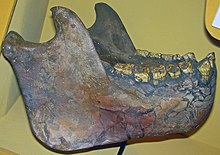| Gigantopithecus Temporal range: Early–Middle Pleistocene
~ | |
|---|---|

| |
| Reconstructed Gigantopithecus mandible at the Cleveland Museum of Natural History, Ohio | |
| Scientific classification | |
| Domain: | Eukaryota |
| Kingdom: | Animalia |
| Phylum: | Chordata |
| Class: | Mammalia |
| Order: | Primates |
| Suborder: | Haplorhini |
| Infraorder: | Simiiformes |
| Family: | Hominidae |
| Tribe: | †Sivapithecini |
| Genus: | †Gigantopithecus |
| Species: | †G. blacki
|
| Binomial name | |
| †Gigantopithecus blacki von Koenigswald, 1935[1]
| |
Gigantopithecus (/dʒaɪˌɡæntoʊpɪˈθikəs, ˈpɪθɪkəs, dʒɪ-/ jahy-gan-toh-pi-thee-kuhs, pith-i-kuhs, ji-;[2] lit. 'giant ape') is an extinct genus of ape that lived in southern China from 2 million to approximately 300,000-200,000 years ago during the Early to Middle Pleistocene, represented by one species, Gigantopithecus blacki.[3][4] Potential identifications have also been made in Thailand, Vietnam, and Indonesia. The first remains of Gigantopithecus, two third molar teeth, were identified in a drugstore by anthropologist Ralph von Koenigswald in 1935, who subsequently described the ape. In 1956, the first mandible and more than 1,000 teeth were found in Liucheng, and numerous more remains have since been found in at least 16 sites. Only teeth and four mandibles are known currently, and other skeletal elements were likely consumed by porcupines before they could fossilise.[5] Gigantopithecus was once argued to be a hominin, a member of the human line, but it is now thought to be closely allied with orangutans, classified in the subfamily Ponginae.
Gigantopithecus has traditionally been restored as a massive, gorilla-like ape, potentially 200–300 kg (440–660 lb) when alive, but the paucity of remains make total size estimates highly speculative. The species may have been sexually dimorphic, with males much bigger than females. The incisors are reduced and the canines appear to have functioned like cheek teeth (premolars and molars). The premolars are high-crowned, and the fourth premolar is very molar-like. The molars are the largest of any known ape, and have a relatively flat surface. Gigantopithecus had the thickest enamel by absolute measure of any ape, up to 6 mm (a quarter of an inch) in some areas, though this is only fairly thick when tooth size is taken into account.
Gigantopithecus appears to have been a generalist herbivore of C3 forest plants, with the jaw adapted to grinding, crushing, and cutting through tough, fibrous plants, and the thick enamel functioning to resist foods with abrasive particles such as stems, roots, and tubers with dirt. Some teeth bear traces of fig family fruits, which may have been important dietary components. It primarily lived in subtropical to tropical forest, and went extinct about 300,000 years ago likely because of the retreat of preferred habitat due to climate change, and potentially archaic human activity. Gigantopithecus has become popular in cryptozoology circles as the identity of the Tibetan yeti or the American bigfoot, apelike creatures in local folklore.
- ^ von Koenigswald, G. H. R. (1935). "Eine fossile Säugetierfauna mit Simia aus Südchina" (PDF). Proceedings of the Koninklijke Akademie van Wetenschappen te Amsterdam. 38 (8): 874–879. Archived (PDF) from the original on 2017-12-12. Retrieved 2017-12-12.
- ^ "Definition of gigantopithecus | Dictionary.com". www.dictionary.com. Archived from the original on 2022-10-03. Retrieved 2022-10-02.
- ^ Tamisiea, Jack (10 January 2024). "The Biggest Ape That Ever Lived Was Not Too Big to Fail - Fossil teeth reveal Gigantopithecus was doomed by a changing environment and an inflexible diet". The New York Times. Archived from the original on 10 January 2024. Retrieved 11 January 2024.
- ^ Zhang, Yingqi; Westaway, Kira E.; Haberle, Simon; Lubeek, Juliën K.; Bailey, Marian; Ciochon, Russell; Morley, Mike W.; Roberts, Patrick; Zhao, Jian-xin; Duval, Mathieu; Dosseto, Anthony; Pan, Yue; Rule, Sue; Liao, Wei; Gully, Grant A.; Lucas, Mary; Mo, Jinyou; Yang, Liyun; Cai, Yanjun; Wang, Wei; Joannes-Boyau, Renaud (10 January 2024). "The demise of the giant ape Gigantopithecus blacki". Nature. 625 (7995): 535–539. Bibcode:2024Natur.625..535Z. doi:10.1038/s41586-023-06900-0. PMC 10794149. PMID 38200315.
- ^ Cite error: The named reference
ZhangHarrison2017was invoked but never defined (see the help page).